MERCEDES-BENZ G550 2010 W463 Owners Manual
Manufacturer: MERCEDES-BENZ, Model Year: 2010, Model line: G550, Model: MERCEDES-BENZ G550 2010 W463Pages: 272, PDF Size: 7.04 MB
Page 91 of 272
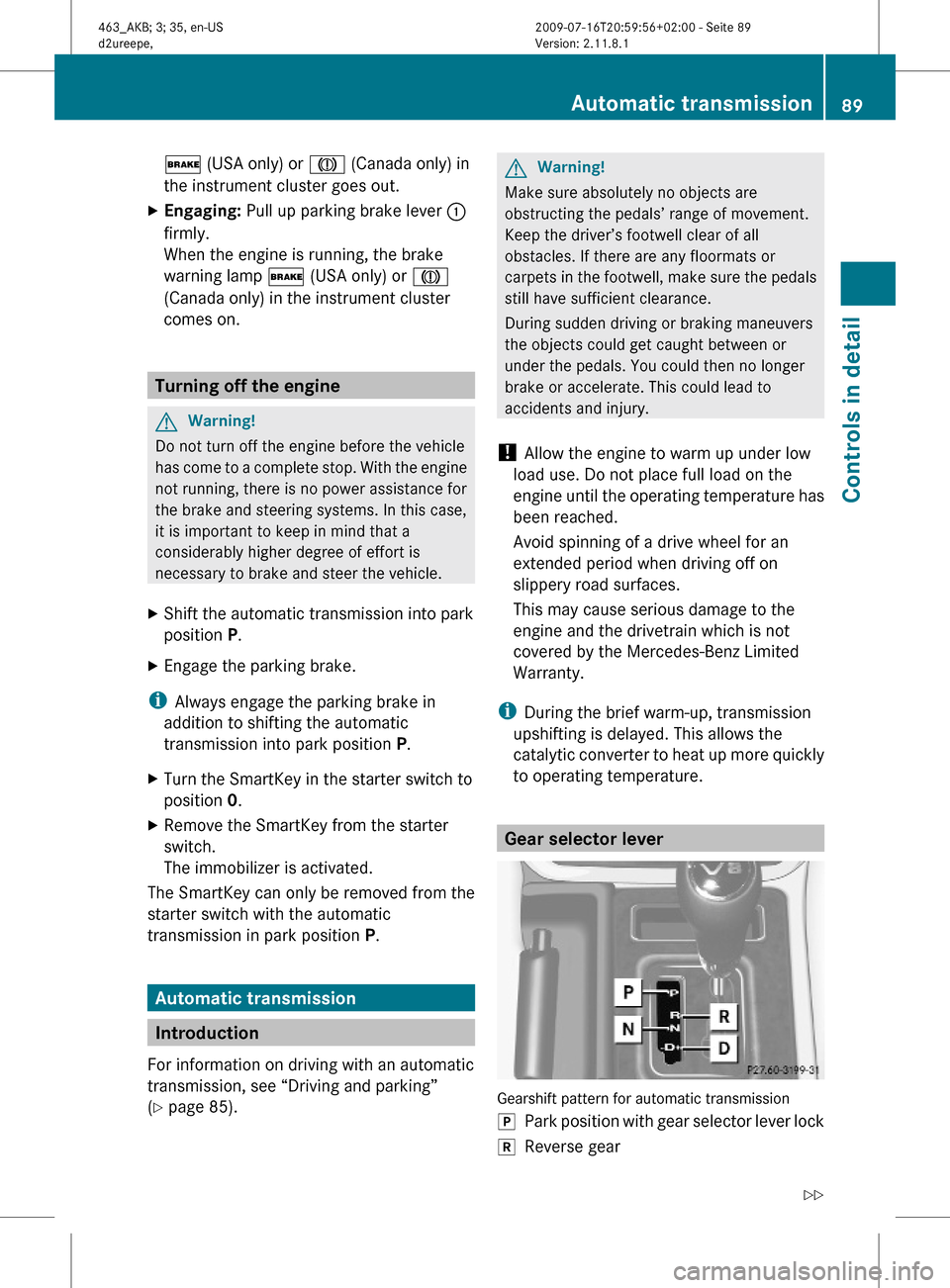
$ (USA only) or J (Canada only) in
the instrument cluster goes out.
XEngaging: Pull up parking brake lever :
firmly.
When the engine is running, the brake
warning lamp $ (USA only) or J
(Canada only) in the instrument cluster
comes on.
Turning off the engine
GWarning!
Do not turn off the engine before the vehicle
has come to a complete stop. With the engine
not running, there is no power assistance for
the brake and steering systems. In this case,
it is important to keep in mind that a
considerably higher degree of effort is
necessary to brake and steer the vehicle.
XShift the automatic transmission into park
position P.
XEngage the parking brake.
iAlways engage the parking brake in
addition to shifting the automatic
transmission into park position P.
XTurn the SmartKey in the starter switch to
position 0.
XRemove the SmartKey from the starter
switch.
The immobilizer is activated.
The SmartKey can only be removed from the
starter switch with the automatic
transmission in park position P.
Automatic transmission
Introduction
For information on driving with an automatic
transmission, see “Driving and parking”
(Y page 85).
GWarning!
Make sure absolutely no objects are
obstructing the pedals’ range of movement.
Keep the driver’s footwell clear of all
obstacles. If there are any floormats or
carpets in the footwell, make sure the pedals
still have sufficient clearance.
During sudden driving or braking maneuvers
the objects could get caught between or
under the pedals. You could then no longer
brake or accelerate. This could lead to
accidents and injury.
! Allow the engine to warm up under low
load use. Do not place full load on the
engine until the operating temperature has
been reached.
Avoid spinning of a drive wheel for an
extended period when driving off on
slippery road surfaces.
This may cause serious damage to the
engine and the drivetrain which is not
covered by the Mercedes-Benz Limited
Warranty.
iDuring the brief warm-up, transmission
upshifting is delayed. This allows the
catalytic converter to heat up more quickly
to operating temperature.
Gear selector lever
Gearshift pattern for automatic transmission
jPark position with gear selector lever lockkReverse gearAutomatic transmission89Controls in detail463_AKB; 3; 35, en-USd2ureepe,Version: 2.11.8.12009-07-16T20:59:56+02:00 - Seite 89Z
Page 92 of 272
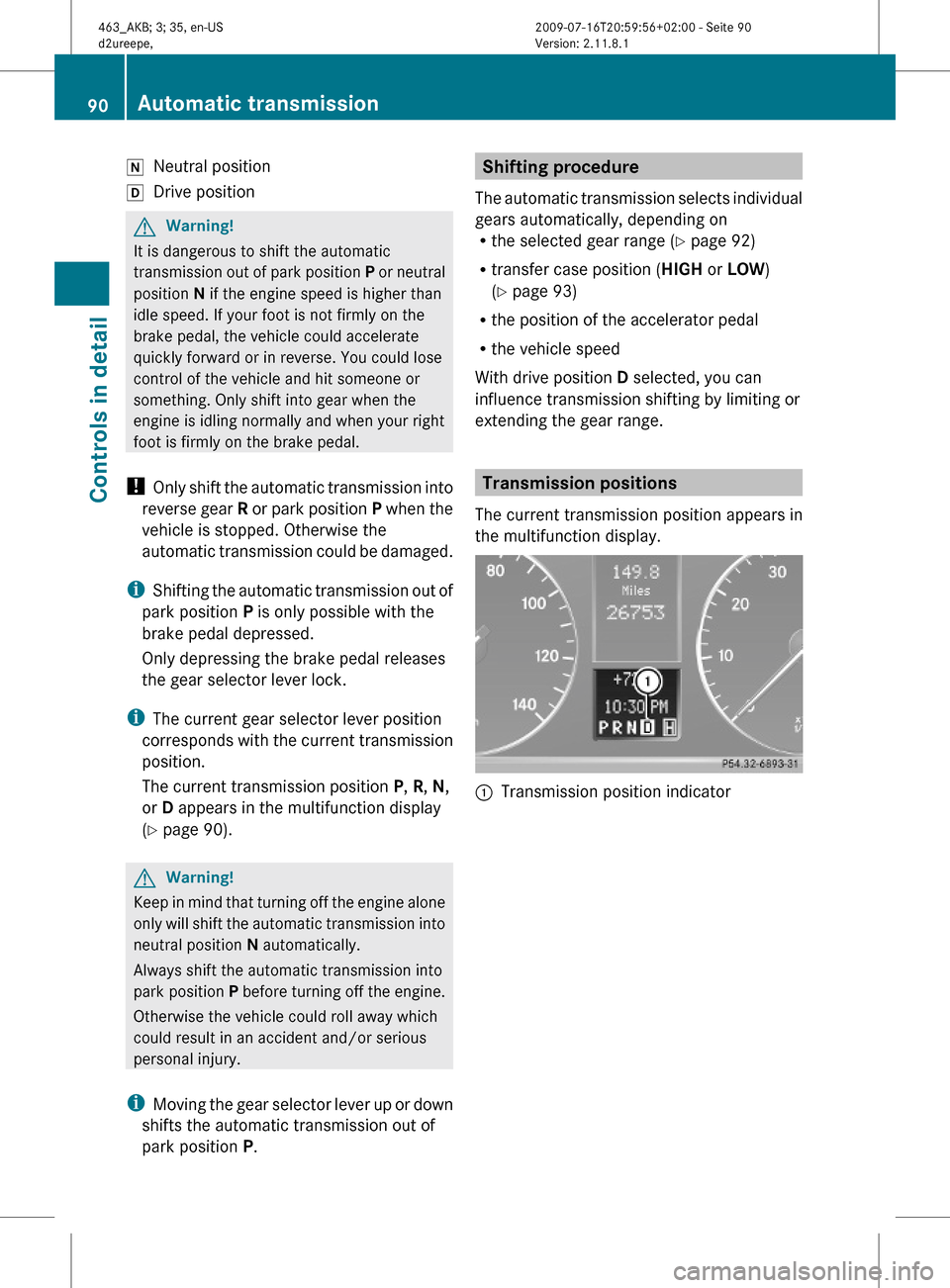
iNeutral positionhDrive positionGWarning!
It is dangerous to shift the automatic
transmission out of park position P or neutral
position N if the engine speed is higher than
idle speed. If your foot is not firmly on the
brake pedal, the vehicle could accelerate
quickly forward or in reverse. You could lose
control of the vehicle and hit someone or
something. Only shift into gear when the
engine is idling normally and when your right
foot is firmly on the brake pedal.
! Only shift the automatic transmission into
reverse gear R or park position P when the
vehicle is stopped. Otherwise the
automatic transmission could be damaged.
iShifting the automatic transmission out of
park position P is only possible with the
brake pedal depressed.
Only depressing the brake pedal releases
the gear selector lever lock.
iThe current gear selector lever position
corresponds with the current transmission
position.
The current transmission position P, R, N,
or D appears in the multifunction display
(Y page 90).
GWarning!
Keep in mind that turning off the engine alone
only will shift the automatic transmission into
neutral position N automatically.
Always shift the automatic transmission into
park position P before turning off the engine.
Otherwise the vehicle could roll away which
could result in an accident and/or serious
personal injury.
iMoving the gear selector lever up or down
shifts the automatic transmission out of
park position P.
Shifting procedure
The automatic transmission selects individual
gears automatically, depending onRthe selected gear range (Y page 92)
Rtransfer case position (HIGH or LOW)
(Y page 93)
Rthe position of the accelerator pedal
Rthe vehicle speed
With drive position D selected, you can
influence transmission shifting by limiting or
extending the gear range.
Transmission positions
The current transmission position appears in
the multifunction display.
:Transmission position indicator 90Automatic transmissionControls in detail
463_AKB; 3; 35, en-USd2ureepe,Version: 2.11.8.12009-07-16T20:59:56+02:00 - Seite 90
Page 93 of 272
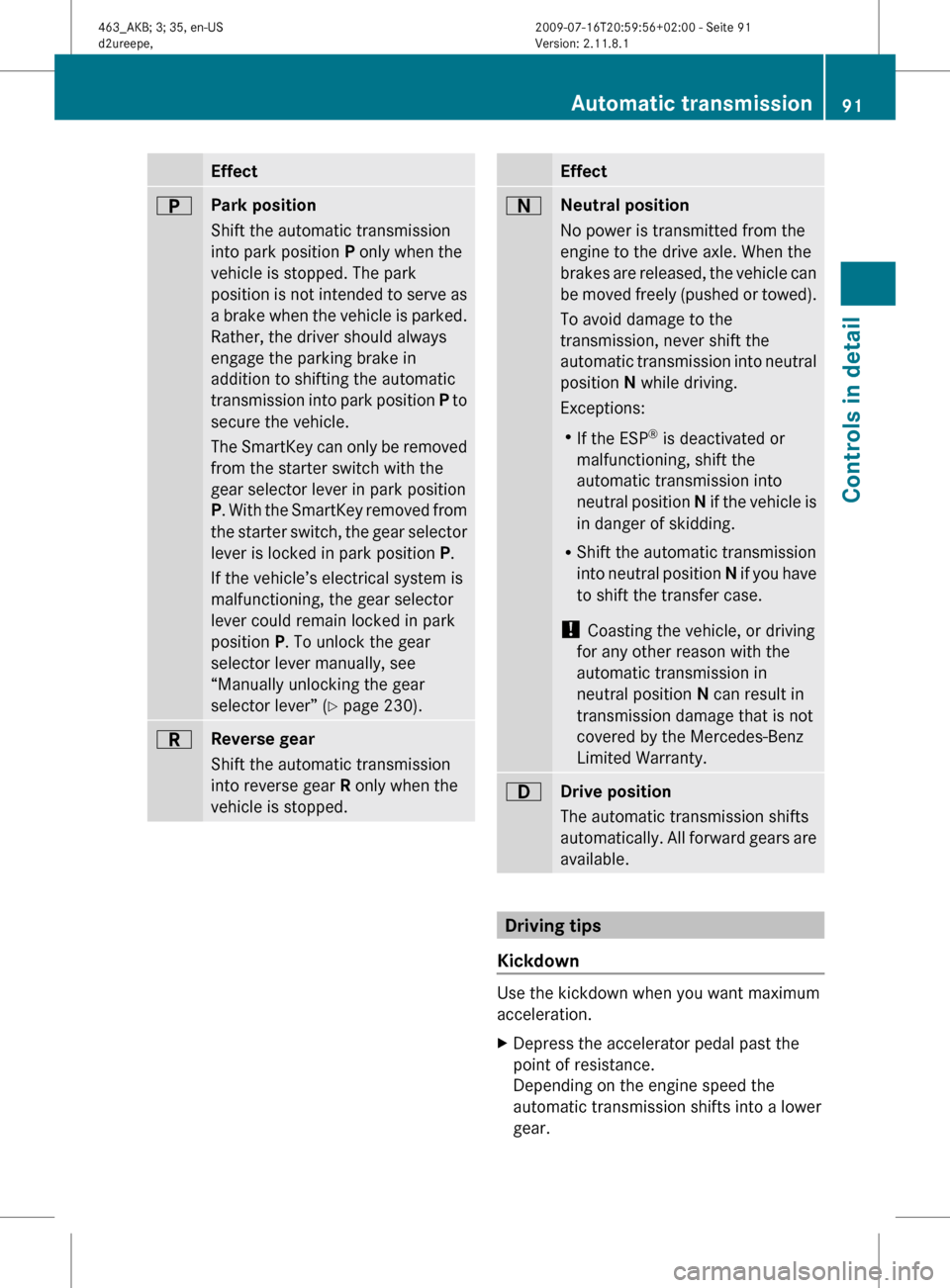
EffectBPark position
Shift the automatic transmission
into park position P only when the
vehicle is stopped. The park
position is not intended to serve as
a brake when the vehicle is parked.
Rather, the driver should always
engage the parking brake in
addition to shifting the automatic
transmission into park position P to
secure the vehicle.
The SmartKey can only be removed
from the starter switch with the
gear selector lever in park position
P . With the SmartKey removed from
the starter switch, the gear selector
lever is locked in park position P.
If the vehicle’s electrical system is
malfunctioning, the gear selector
lever could remain locked in park
position P. To unlock the gear
selector lever manually, see
“Manually unlocking the gear
selector lever” ( Y page 230).CReverse gear
Shift the automatic transmission
into reverse gear R only when the
vehicle is stopped.EffectANeutral position
No power is transmitted from the
engine to the drive axle. When the
brakes are released, the vehicle can
be moved freely (pushed or towed).
To avoid damage to the
transmission, never shift the
automatic transmission into neutral
position N while driving.
Exceptions:
R If the ESP ®
is deactivated or
malfunctioning, shift the
automatic transmission into
neutral position N if the vehicle is
in danger of skidding.
R Shift the automatic transmission
into neutral position N if you have
to shift the transfer case.
! Coasting the vehicle, or driving
for any other reason with the
automatic transmission in
neutral position N can result in
transmission damage that is not
covered by the Mercedes-Benz
Limited Warranty.7Drive position
The automatic transmission shifts
automatically. All forward gears are
available.
Driving tips
Kickdown
Use the kickdown when you want maximum
acceleration.
XDepress the accelerator pedal past the
point of resistance.
Depending on the engine speed the
automatic transmission shifts into a lower
gear.Automatic transmission91Controls in detail463_AKB; 3; 35, en-USd2ureepe,Version: 2.11.8.12009-07-16T20:59:56+02:00 - Seite 91Z
Page 94 of 272
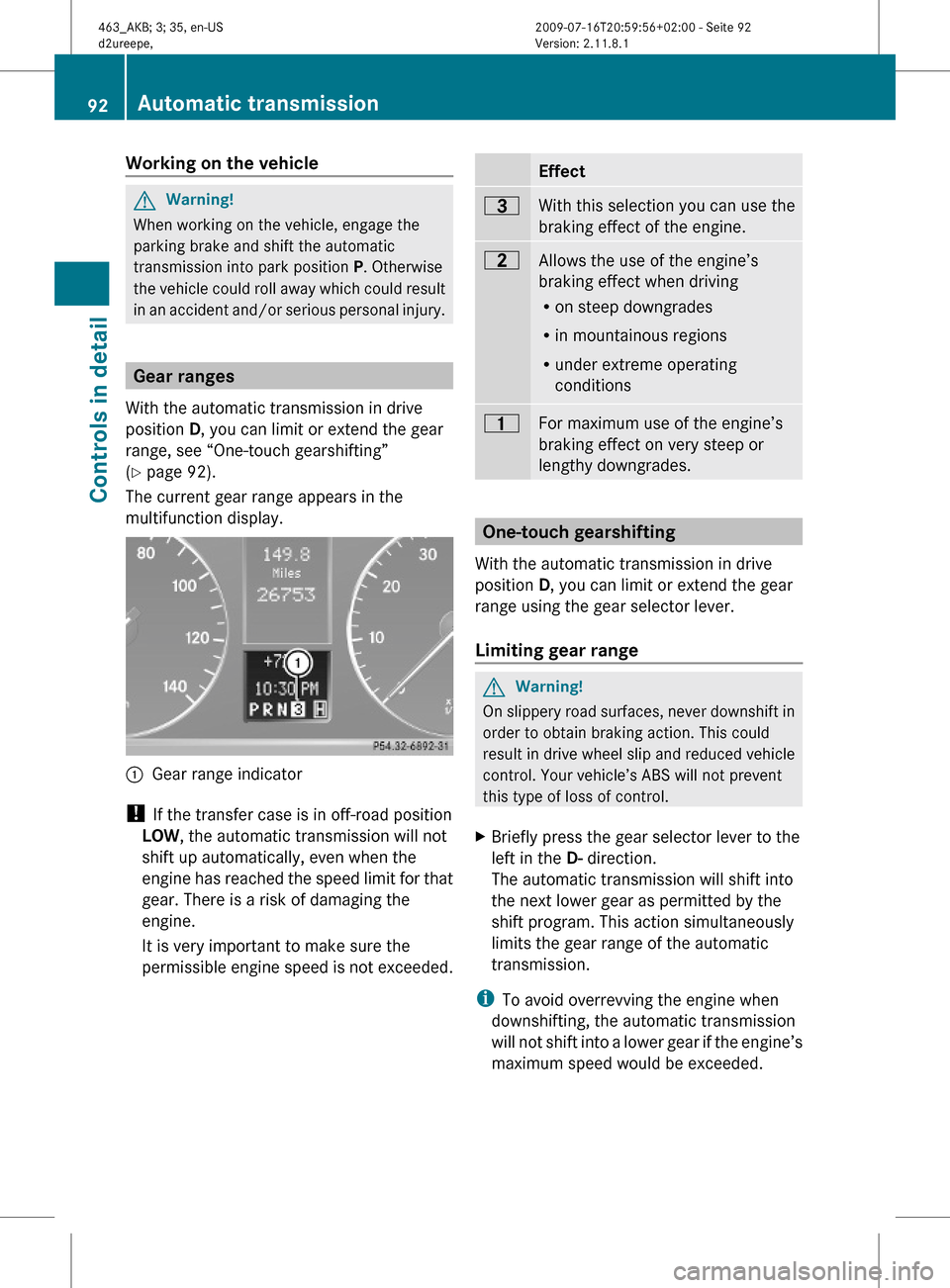
Working on the vehicleGWarning!
When working on the vehicle, engage the
parking brake and shift the automatic
transmission into park position P. Otherwise
the vehicle could roll away which could result
in an accident and/or serious personal injury.
Gear ranges
With the automatic transmission in drive
position D, you can limit or extend the gear
range, see “One-touch gearshifting”
(Y page 92).
The current gear range appears in the
multifunction display.
:Gear range indicator
! If the transfer case is in off-road position
LOW, the automatic transmission will not
shift up automatically, even when the
engine has reached the speed limit for that
gear. There is a risk of damaging the
engine.
It is very important to make sure the
permissible engine speed is not exceeded.
Effect=With this selection you can use the
braking effect of the engine.
5Allows the use of the engine’s
braking effect when driving
Ron steep downgrades
Rin mountainous regions
Runder extreme operating
conditions
4For maximum use of the engine’s
braking effect on very steep or
lengthy downgrades.
One-touch gearshifting
With the automatic transmission in drive
position D, you can limit or extend the gear
range using the gear selector lever.
Limiting gear range
GWarning!
On slippery road surfaces, never downshift in
order to obtain braking action. This could
result in drive wheel slip and reduced vehicle
control. Your vehicle’s ABS will not prevent
this type of loss of control.
XBriefly press the gear selector lever to the
left in the D- direction.
The automatic transmission will shift into
the next lower gear as permitted by the
shift program. This action simultaneously
limits the gear range of the automatic
transmission.
iTo avoid overrevving the engine when
downshifting, the automatic transmission
will not shift into a lower gear if the engine’s
maximum speed would be exceeded.
92Automatic transmissionControls in detail
463_AKB; 3; 35, en-USd2ureepe,Version: 2.11.8.12009-07-16T20:59:56+02:00 - Seite 92
Page 95 of 272
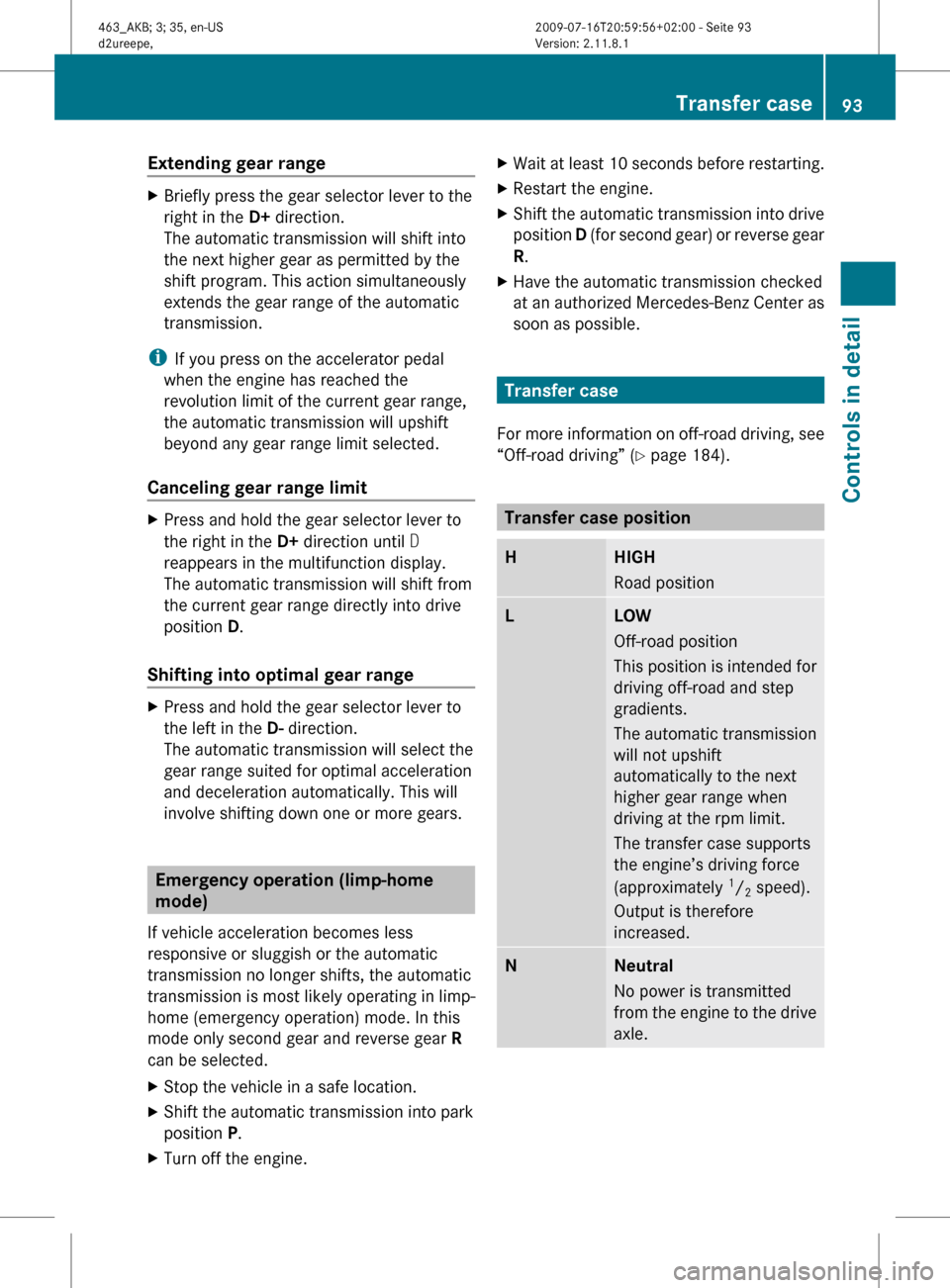
Extending gear rangeXBriefly press the gear selector lever to the
right in the D+ direction.
The automatic transmission will shift into
the next higher gear as permitted by the
shift program. This action simultaneously
extends the gear range of the automatic
transmission.
i If you press on the accelerator pedal
when the engine has reached the
revolution limit of the current gear range,
the automatic transmission will upshift
beyond any gear range limit selected.
Canceling gear range limit
XPress and hold the gear selector lever to
the right in the D+ direction until D
reappears in the multifunction display.
The automatic transmission will shift from
the current gear range directly into drive
position D.
Shifting into optimal gear range
XPress and hold the gear selector lever to
the left in the D- direction.
The automatic transmission will select the
gear range suited for optimal acceleration
and deceleration automatically. This will
involve shifting down one or more gears.
Emergency operation (limp-home
mode)
If vehicle acceleration becomes less
responsive or sluggish or the automatic
transmission no longer shifts, the automatic
transmission is most likely operating in limp-
home (emergency operation) mode. In this
mode only second gear and reverse gear R
can be selected.
XStop the vehicle in a safe location.XShift the automatic transmission into park
position P.XTurn off the engine.XWait at least 10 seconds before restarting.XRestart the engine.XShift the automatic transmission into drive
position D (for second gear) or reverse gear
R .XHave the automatic transmission checked
at an authorized Mercedes-Benz Center as
soon as possible.
Transfer case
For more information on off-road driving, see
“Off-road driving” ( Y page 184).
Transfer case position
HHIGH
Road positionLLOW
Off-road position
This position is intended for
driving off-road and step
gradients.
The automatic transmission
will not upshift
automatically to the next
higher gear range when
driving at the rpm limit.
The transfer case supports
the engine’s driving force
(approximately 1
/ 2 speed).
Output is therefore
increased.NNeutral
No power is transmitted
from the engine to the drive
axle.Transfer case93Controls in detail463_AKB; 3; 35, en-USd2ureepe,Version: 2.11.8.12009-07-16T20:59:56+02:00 - Seite 93Z
Page 96 of 272
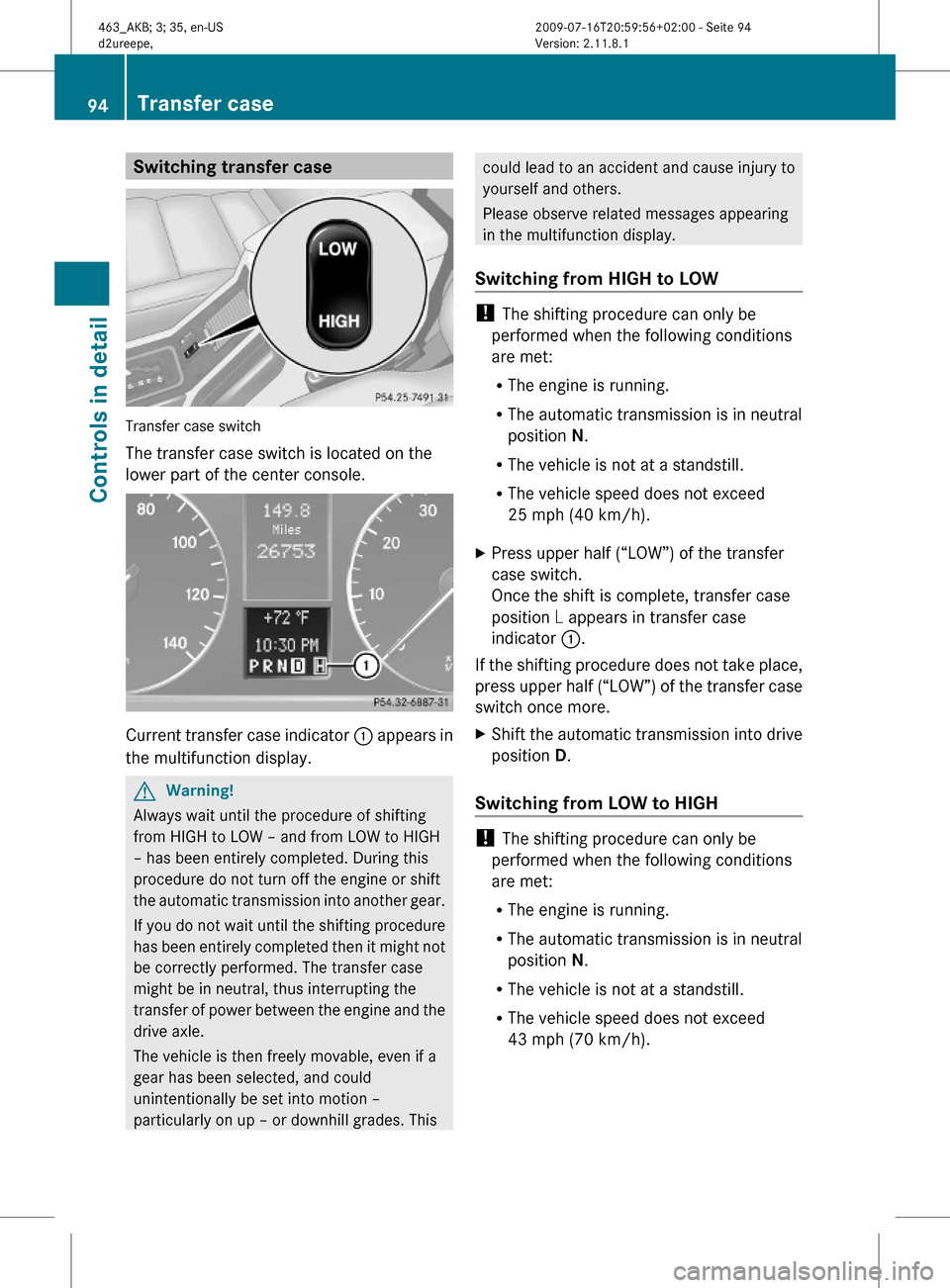
Switching transfer case
Transfer case switch
The transfer case switch is located on the
lower part of the center console.
Current transfer case indicator : appears in
the multifunction display.
GWarning!
Always wait until the procedure of shifting
from HIGH to LOW – and from LOW to HIGH
– has been entirely completed. During this
procedure do not turn off the engine or shift
the automatic transmission into another gear.
If you do not wait until the shifting procedure
has been entirely completed then it might not
be correctly performed. The transfer case
might be in neutral, thus interrupting the
transfer of power between the engine and the
drive axle.
The vehicle is then freely movable, even if a
gear has been selected, and could
unintentionally be set into motion –
particularly on up – or downhill grades. This
could lead to an accident and cause injury to
yourself and others.
Please observe related messages appearing
in the multifunction display.
Switching from HIGH to LOW
! The shifting procedure can only be
performed when the following conditions
are met:
RThe engine is running.
RThe automatic transmission is in neutral
position N.
RThe vehicle is not at a standstill.
RThe vehicle speed does not exceed
25 mph (40 km/h).
XPress upper half (“LOW”) of the transfer
case switch.
Once the shift is complete, transfer case
position L appears in transfer case
indicator :.
If the shifting procedure does not take place,
press upper half (“LOW”) of the transfer case
switch once more.
XShift the automatic transmission into drive
position D.
Switching from LOW to HIGH
! The shifting procedure can only be
performed when the following conditions
are met:
RThe engine is running.
RThe automatic transmission is in neutral
position N.
RThe vehicle is not at a standstill.
RThe vehicle speed does not exceed
43 mph (70 km/h).
94Transfer caseControls in detail
463_AKB; 3; 35, en-USd2ureepe,Version: 2.11.8.12009-07-16T20:59:56+02:00 - Seite 94
Page 97 of 272
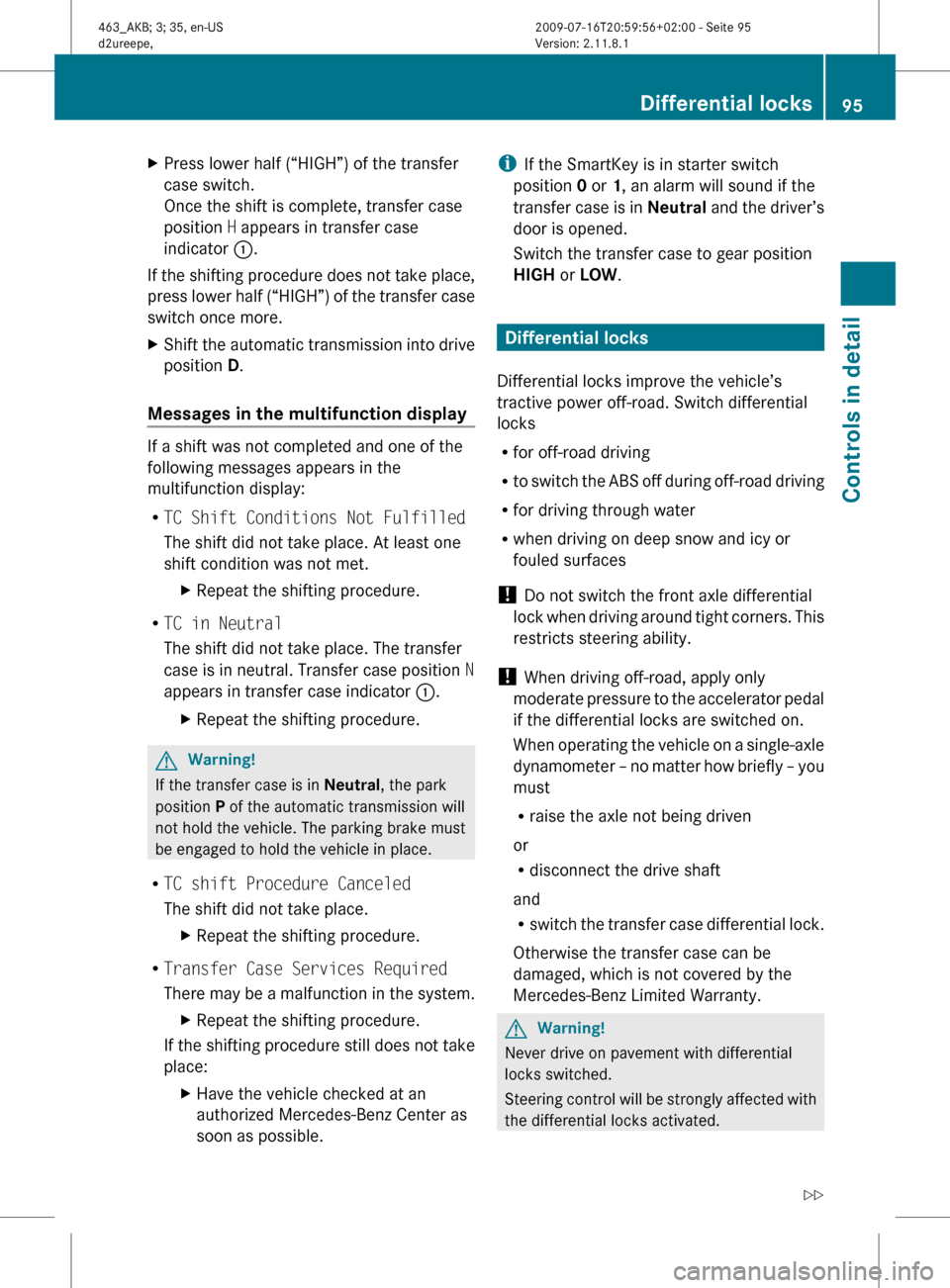
XPress lower half (“HIGH”) of the transfer
case switch.
Once the shift is complete, transfer case
position H appears in transfer case
indicator :.
If the shifting procedure does not take place,
press lower half (“HIGH”) of the transfer case
switch once more.
XShift the automatic transmission into drive
position D.
Messages in the multifunction display
If a shift was not completed and one of the
following messages appears in the
multifunction display:
R TC Shift Conditions Not Fulfilled
The shift did not take place. At least one
shift condition was not met.
XRepeat the shifting procedure.
R TC in Neutral
The shift did not take place. The transfer
case is in neutral. Transfer case position N
appears in transfer case indicator :.
XRepeat the shifting procedure.GWarning!
If the transfer case is in Neutral, the park
position P of the automatic transmission will
not hold the vehicle. The parking brake must
be engaged to hold the vehicle in place.
R TC shift Procedure Canceled
The shift did not take place.
XRepeat the shifting procedure.
R Transfer Case Services Required
There may be a malfunction in the system.
XRepeat the shifting procedure.
If the shifting procedure still does not take
place:
XHave the vehicle checked at an
authorized Mercedes-Benz Center as
soon as possible.i If the SmartKey is in starter switch
position 0 or 1, an alarm will sound if the
transfer case is in Neutral and the driver’s
door is opened.
Switch the transfer case to gear position
HIGH or LOW .
Differential locks
Differential locks improve the vehicle’s
tractive power off-road. Switch differential
locks
R for off-road driving
R to switch the ABS off during off-road driving
R for driving through water
R when driving on deep snow and icy or
fouled surfaces
! Do not switch the front axle differential
lock when driving around tight corners. This
restricts steering ability.
! When driving off-road, apply only
moderate pressure to the accelerator pedal
if the differential locks are switched on.
When operating the vehicle on a single-axle
dynamometer – no matter how briefly – you
must
R raise the axle not being driven
or
R disconnect the drive shaft
and
R switch the transfer case differential lock.
Otherwise the transfer case can be
damaged, which is not covered by the
Mercedes-Benz Limited Warranty.
GWarning!
Never drive on pavement with differential
locks switched.
Steering control will be strongly affected with
the differential locks activated.
Differential locks95Controls in detail463_AKB; 3; 35, en-USd2ureepe,Version: 2.11.8.12009-07-16T20:59:56+02:00 - Seite 95Z
Page 98 of 272
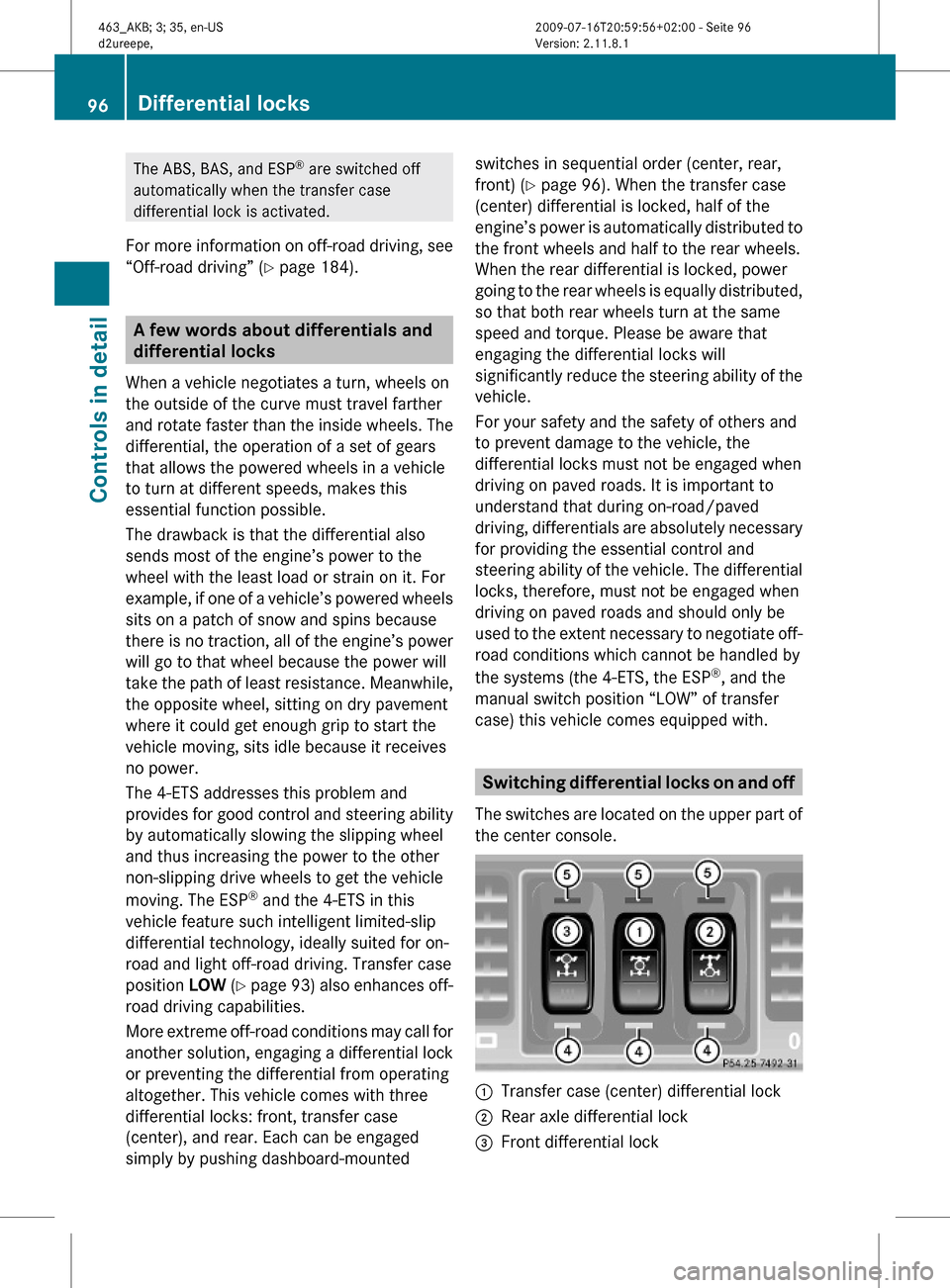
The ABS, BAS, and ESP® are switched off
automatically when the transfer case
differential lock is activated.
For more information on off-road driving, see
“Off-road driving” (Y page 184).
A few words about differentials and
differential locks
When a vehicle negotiates a turn, wheels on
the outside of the curve must travel farther
and rotate faster than the inside wheels. The
differential, the operation of a set of gears
that allows the powered wheels in a vehicle
to turn at different speeds, makes this
essential function possible.
The drawback is that the differential also
sends most of the engine’s power to the
wheel with the least load or strain on it. For
example, if one of a vehicle’s powered wheels
sits on a patch of snow and spins because
there is no traction, all of the engine’s power
will go to that wheel because the power will
take the path of least resistance. Meanwhile,
the opposite wheel, sitting on dry pavement
where it could get enough grip to start the
vehicle moving, sits idle because it receives
no power.
The 4-ETS addresses this problem and
provides for good control and steering ability
by automatically slowing the slipping wheel
and thus increasing the power to the other
non-slipping drive wheels to get the vehicle
moving. The ESP® and the 4-ETS in this
vehicle feature such intelligent limited-slip
differential technology, ideally suited for on-
road and light off-road driving. Transfer case
position LOW (Y page 93) also enhances off-
road driving capabilities.
More extreme off-road conditions may call for
another solution, engaging a differential lock
or preventing the differential from operating
altogether. This vehicle comes with three
differential locks: front, transfer case
(center), and rear. Each can be engaged
simply by pushing dashboard-mounted
switches in sequential order (center, rear,
front) (Y page 96). When the transfer case
(center) differential is locked, half of the
engine’s power is automatically distributed to
the front wheels and half to the rear wheels.
When the rear differential is locked, power
going to the rear wheels is equally distributed,
so that both rear wheels turn at the same
speed and torque. Please be aware that
engaging the differential locks will
significantly reduce the steering ability of the
vehicle.
For your safety and the safety of others and
to prevent damage to the vehicle, the
differential locks must not be engaged when
driving on paved roads. It is important to
understand that during on-road/paved
driving, differentials are absolutely necessary
for providing the essential control and
steering ability of the vehicle. The differential
locks, therefore, must not be engaged when
driving on paved roads and should only be
used to the extent necessary to negotiate off-
road conditions which cannot be handled by
the systems (the 4-ETS, the ESP®, and the
manual switch position “LOW” of transfer
case) this vehicle comes equipped with.
Switching differential locks on and off
The switches are located on the upper part of
the center console.
:Transfer case (center) differential lock;Rear axle differential lock=Front differential lock96Differential locksControls in detail
463_AKB; 3; 35, en-USd2ureepe,Version: 2.11.8.12009-07-16T20:59:56+02:00 - Seite 96
Page 99 of 272
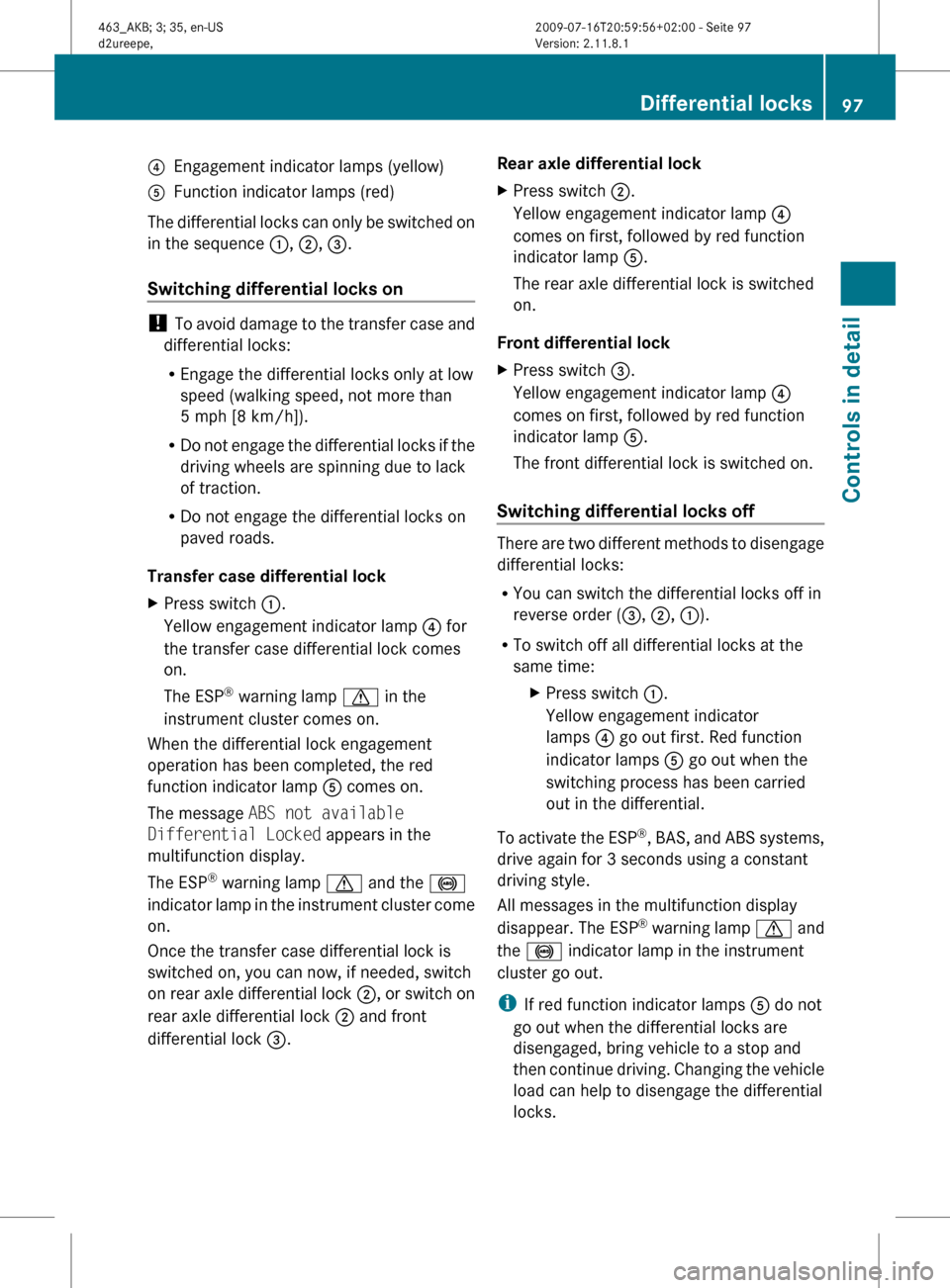
?Engagement indicator lamps (yellow)AFunction indicator lamps (red)
The differential locks can only be switched on
in the sequence :, ; , = .
Switching differential locks on
! To avoid damage to the transfer case and
differential locks:
R Engage the differential locks only at low
speed (walking speed, not more than
5 mph [8 km/h]).
R Do not engage the differential locks if the
driving wheels are spinning due to lack
of traction.
R Do not engage the differential locks on
paved roads.
Transfer case differential lock
XPress switch :.
Yellow engagement indicator lamp ? for
the transfer case differential lock comes
on.
The ESP ®
warning lamp d in the
instrument cluster comes on.
When the differential lock engagement
operation has been completed, the red
function indicator lamp A comes on.
The message ABS not available
Differential Locked appears in the
multifunction display.
The ESP ®
warning lamp d and the !
indicator lamp in the instrument cluster come
on.
Once the transfer case differential lock is
switched on, you can now, if needed, switch
on rear axle differential lock ;, or switch on
rear axle differential lock ; and front
differential lock =.
Rear axle differential lockXPress switch ;.
Yellow engagement indicator lamp ?
comes on first, followed by red function
indicator lamp A.
The rear axle differential lock is switched
on.
Front differential lock
XPress switch =.
Yellow engagement indicator lamp ?
comes on first, followed by red function
indicator lamp A.
The front differential lock is switched on.
Switching differential locks off
There are two different methods to disengage
differential locks:
R You can switch the differential locks off in
reverse order ( =, ; , : ).
R To switch off all differential locks at the
same time:
XPress switch :.
Yellow engagement indicator
lamps ? go out first. Red function
indicator lamps A go out when the
switching process has been carried
out in the differential.
To activate the ESP ®
, BAS, and ABS systems,
drive again for 3 seconds using a constant
driving style.
All messages in the multifunction display
disappear. The ESP ®
warning lamp d and
the ! indicator lamp in the instrument
cluster go out.
i If red function indicator lamps A do not
go out when the differential locks are
disengaged, bring vehicle to a stop and
then continue driving. Changing the vehicle
load can help to disengage the differential
locks.
Differential locks97Controls in detail463_AKB; 3; 35, en-USd2ureepe,Version: 2.11.8.12009-07-16T20:59:56+02:00 - Seite 97Z
Page 100 of 272
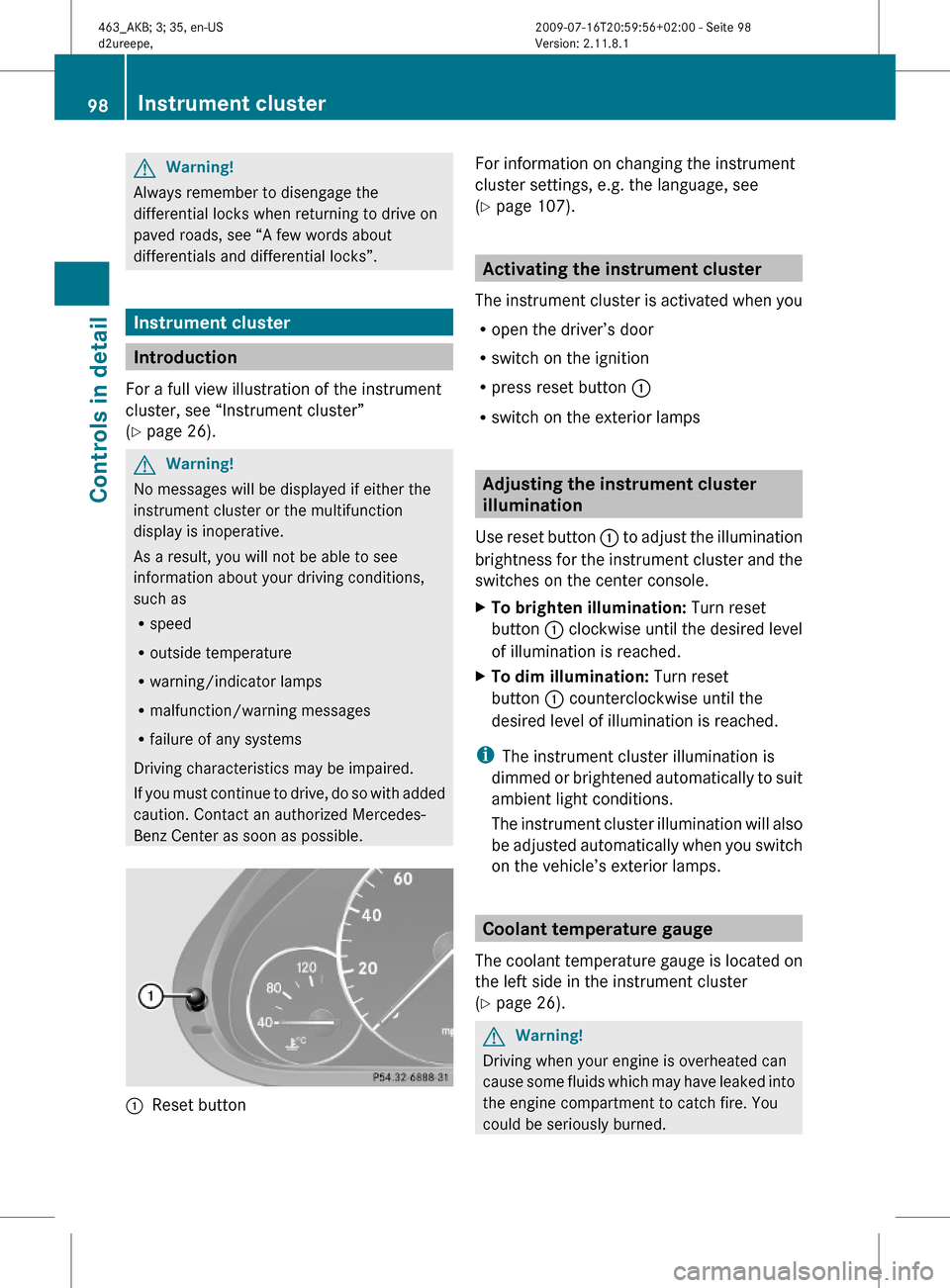
GWarning!
Always remember to disengage the
differential locks when returning to drive on
paved roads, see “A few words about
differentials and differential locks”.
Instrument cluster
Introduction
For a full view illustration of the instrument
cluster, see “Instrument cluster”
(Y page 26).
GWarning!
No messages will be displayed if either the
instrument cluster or the multifunction
display is inoperative.
As a result, you will not be able to see
information about your driving conditions,
such as
Rspeed
Routside temperature
Rwarning/indicator lamps
Rmalfunction/warning messages
Rfailure of any systems
Driving characteristics may be impaired.
If you must continue to drive, do so with added
caution. Contact an authorized Mercedes-
Benz Center as soon as possible.
:Reset button For information on changing the instrument
cluster settings, e.g. the language, see
(Y page 107).
Activating the instrument cluster
The instrument cluster is activated when you
Ropen the driver’s door
Rswitch on the ignition
Rpress reset button :
Rswitch on the exterior lamps
Adjusting the instrument cluster
illumination
Use reset button : to adjust the illumination
brightness for the instrument cluster and the
switches on the center console.
XTo brighten illumination: Turn reset
button : clockwise until the desired level
of illumination is reached.
XTo dim illumination: Turn reset
button : counterclockwise until the
desired level of illumination is reached.
iThe instrument cluster illumination is
dimmed or brightened automatically to suit
ambient light conditions.
The instrument cluster illumination will also
be adjusted automatically when you switch
on the vehicle’s exterior lamps.
Coolant temperature gauge
The coolant temperature gauge is located on
the left side in the instrument cluster
(Y page 26).
GWarning!
Driving when your engine is overheated can
cause some fluids which may have leaked into
the engine compartment to catch fire. You
could be seriously burned.
98Instrument clusterControls in detail
463_AKB; 3; 35, en-USd2ureepe,Version: 2.11.8.12009-07-16T20:59:56+02:00 - Seite 98